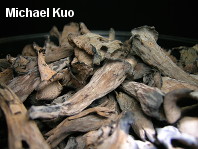| Major Groups > Chanterelles and Trumpets > Craterellus fallax |

|
Craterellus fallax [ Basidiomycota > Cantharellales > Cantharellaceae > Craterellus . . . ] by Michael Kuo This fascinating mushroom, often called the "black trumpet," is common and easily recognized--but hard to discover. The mushrooms are small and black, and something about their shape and fruiting pattern can make them extremely difficult to see. The vase-shaped fruiting bodies have finely scaly, gray to black upper surfaces and smooth or very shallowly wrinkled outer surfaces that are initially blackish but develop yellowish to orangish shades as the spores mature. An early molecular study (Dahlman et al., 2000) synonymized Craterellus fallax with the European species Craterellus cornucopioides, but the study was based on a single gene (the large subunit of RNA, known as LSU) that has since been re-evaluated as useful for determining large taxonomic units (families, genera, species groups) but not generally reliable for the determination of individual species. A more recent study (Matheny et al., 2010) used an additional gene (the internally transcribed spacer, or ITS) that is considered more reliable for species-level analysis, and determined that Craterellus fallax is indeed a separate species. The genetic difference is accompanied by a difference in the color of the spore print; Craterellus fallax has a yellowish to orangish print, while Europe's Craterellus cornucopioides has a white print. The West-Coast version of the black trumpet, which has a whitish to creamy spore print, is Craterellus species 01. Description: Ecology: Mycorrhizal with oaks, and perhaps with other hardwoods; growing alone, scattered, gregariously, or in loose clusters (only rarely in tightly packed clusters of many mushrooms); often found in mossy areas; spring through fall; widely distributed east of the Rocky Mountains. The illustrated and described collections are from Illinois and Pennsylvania. Fruiting Body: 1-5 cm wide; 3-9 cm high; without a clearly defined cap and stem; tubular at first, becoming deeply vase-shaped; the upper edge rolled under when young and often partly rolled under in maturity; thin-fleshed. Upper/Inner Surface: Pale to dark gray; minutely scaly with blackish-tipped scales over a paler, grayish or grayish brown base color; the margin often black. Under/Outer Surface: Smooth or very shallowly wrinkled; dark gray to black, becoming dull gray with orangish or yellowish tints; darker toward the base; basal mycelium white. Flesh: Thin and brittle; gray to blackish. Odor and Taste: Taste mild; odor not distinctive, or somewhat fragrant. Chemical Reactions: KOH negative on all surfaces. Spore Print: Pale pinkish orange. Microscopic Features: Spores 10-15 x 7-10 µ; broadly ellipsoid; smooth; hyaline in KOH; contents homogeneous. Basidia 60-70 µ long; 2-sterigmate, or occasionally 3-sterigmate. Hymenial cystidia not found. Elements of upper surface cylindric; septate; hyaline to brownish; 5-20 µ wide. Clamp connections absent. REFERENCES: A. H. Smith, 1968. (Petersen, 1975; Smith, Smith & Weber, 1981; Phillips, 1991/2005; Lincoff, 1992; Metzler & Metzler, 1992; Horn, Kay & Abel, 1993; Barron, 1999; Dahlman et al., 2000; Roody, 2003; McNeil, 2006; Miller & Miller, 2006; Matheny et al., 2010; Kuo & Methven, 2014.) Herb. Kuo 07079404, 06160305, 07120705, 06221302. This site contains no information about the edibility or toxicity of mushrooms. |
© MushroomExpert.Com |
|
Cite this page as: Kuo, M. (2015, February). Craterellus fallax. Retrieved from the MushroomExpert.Com Web site: http://www.mushroomexpert.com/craterellus_fallax.html |







